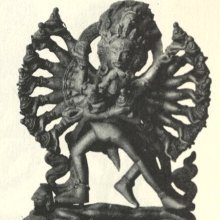Vishvadaka, Viśvaḍāka, Vishva-daka: 3 definitions
Introduction:
Vishvadaka means something in Buddhism, Pali. If you want to know the exact meaning, history, etymology or English translation of this term then check out the descriptions on this page. Add your comment or reference to a book if you want to contribute to this summary article.
The Sanskrit term Viśvaḍāka can be transliterated into English as Visvadaka or Vishvadaka, using the IAST transliteration scheme (?).
Images (photo gallery)
In Buddhism
Tibetan Buddhism (Vajrayana or tantric Buddhism)
Source: Wisdom Library: Tibetan BuddhismViśvaḍāka (विश्वडाक) is the name of a deity presiding a group of four sacred districts, according to the Abhidhānottarottaratantra and the 9th-centruy Vajraḍākatantra.—Accordingly, Viśvaḍāka presides over the districts Nagara, Sindhu, Maru and Kulatā.
Source: Google Books: An Illustrated History of the MandalaViśvaḍāka (विश्वडाक) corresponds to the Buddha named Paramāśva and represents the main deity of the northern maṇḍala of the Pañcaḍākamaṇḍala, according to the Vajrapañjaratantra. In the Maṇḍala chapel in Tsaparang in western Tibet, there has survived a wall painting of the Pañcaḍāka in which Viśvaḍāka is depicted as horse-headed. This confrims the fact that Viśvaḍāka corresponds to Paramāśva, since this iconography was inherited from the earlier iconography of Paramāśva.
Source: academia.edu: The Structure and Meanings of the Heruka MaṇḍalaViśvaḍāka (विश्वडाक) is the name of a Vīra (hero) who, together with the Ḍākinī named Lāmā forms one of the 36 pairs situated in the Vajracakra, according to the 10th century Ḍākārṇava chapter 15. Accordingly, the vajracakra refers to one of the four divisions of the sahaja-puṭa (‘innate layer’), situated within the padma (lotus) in the middle of the Herukamaṇḍala. The 36 pairs of Ḍākinīs and Vīras [viz., Viśvaḍāka] each have one face and four arms; they hold a skull bowl, a skull staff, a small drum and a knife; they are dark-bluish-black in color.

Tibetan Buddhism includes schools such as Nyingma, Kadampa, Kagyu and Gelug. Their primary canon of literature is divided in two broad categories: The Kangyur, which consists of Buddha’s words, and the Tengyur, which includes commentaries from various sources. Esotericism and tantra techniques (vajrayāna) are collected indepently.
See also (Relevant definitions)
Partial matches: Daka, Vishva.
Full-text: Vishwadak, Sindhu, Kulata, Lama, Vajracakra, Nagara, Maru.
Relevant text
No search results for Vishvadaka, Viśvaḍāka, Vishva-daka, Visvadaka, Viśva-ḍāka, Visva-daka; (plurals include: Vishvadakas, Viśvaḍākas, dakas, Visvadakas, ḍākas) in any book or story.
